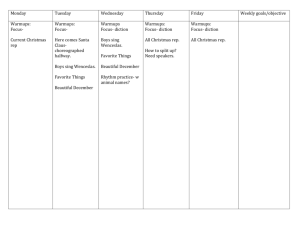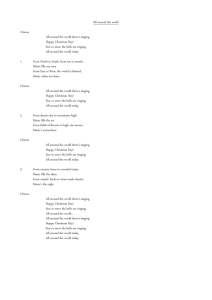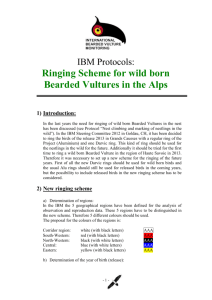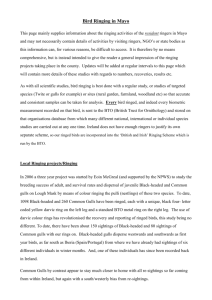Name of data set Background
advertisement
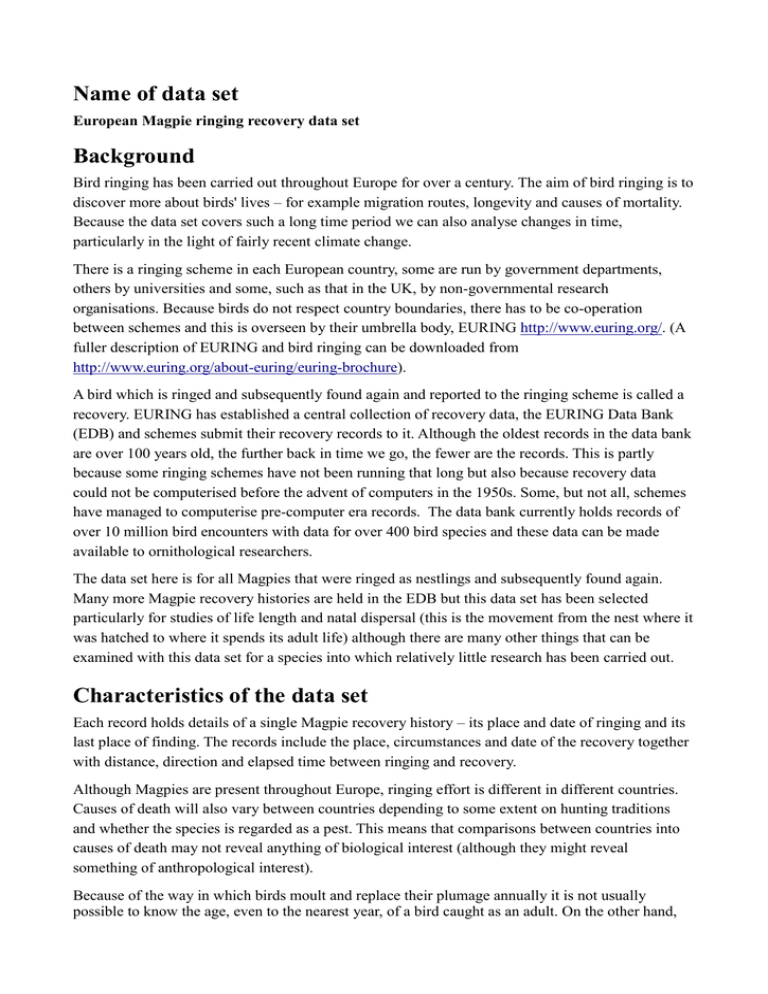
Name of data set European Magpie ringing recovery data set Background Bird ringing has been carried out throughout Europe for over a century. The aim of bird ringing is to discover more about birds' lives – for example migration routes, longevity and causes of mortality. Because the data set covers such a long time period we can also analyse changes in time, particularly in the light of fairly recent climate change. There is a ringing scheme in each European country, some are run by government departments, others by universities and some, such as that in the UK, by non-governmental research organisations. Because birds do not respect country boundaries, there has to be co-operation between schemes and this is overseen by their umbrella body, EURING http://www.euring.org/. (A fuller description of EURING and bird ringing can be downloaded from http://www.euring.org/about-euring/euring-brochure). A bird which is ringed and subsequently found again and reported to the ringing scheme is called a recovery. EURING has established a central collection of recovery data, the EURING Data Bank (EDB) and schemes submit their recovery records to it. Although the oldest records in the data bank are over 100 years old, the further back in time we go, the fewer are the records. This is partly because some ringing schemes have not been running that long but also because recovery data could not be computerised before the advent of computers in the 1950s. Some, but not all, schemes have managed to computerise pre-computer era records. The data bank currently holds records of over 10 million bird encounters with data for over 400 bird species and these data can be made available to ornithological researchers. The data set here is for all Magpies that were ringed as nestlings and subsequently found again. Many more Magpie recovery histories are held in the EDB but this data set has been selected particularly for studies of life length and natal dispersal (this is the movement from the nest where it was hatched to where it spends its adult life) although there are many other things that can be examined with this data set for a species into which relatively little research has been carried out. Characteristics of the data set Each record holds details of a single Magpie recovery history – its place and date of ringing and its last place of finding. The records include the place, circumstances and date of the recovery together with distance, direction and elapsed time between ringing and recovery. Although Magpies are present throughout Europe, ringing effort is different in different countries. Causes of death will also vary between countries depending to some extent on hunting traditions and whether the species is regarded as a pest. This means that comparisons between countries into causes of death may not reveal anything of biological interest (although they might reveal something of anthropological interest). Because of the way in which birds moult and replace their plumage annually it is not usually possible to know the age, even to the nearest year, of a bird caught as an adult. On the other hand, birds ringed as nestlings are of known age and known place of origin. For this reason this data set has been selected to include only birds ringed as nestlings, typically two weeks after hatching. Thus for birds found recently dead we know, to within less than a month, their exact ages at death. This data set is, therefore, aimed at analyses of life length and dispersal. Some analyses using dead and live recoveries my give different results. For instance, an analysis of life length using live encounters is likely to underestimate the average life length. Other analyses (e.g. distance moved within a given time) may not be affected by the recovery circumstances. Data set information The data set is supplied in comma separated value format which is suitable for loading directly into statistical packages or spreadsheets. Fields Field Name Description Codes, Units, Notes Identity Ringing scheme and ring number This gives each record a unique identity but may have no use in any analysis Day of ringing Range 1 - 31 Integer Month of ringing Range 1 - 12 Integer Year of ringing Range 1913 - 2014 Integer, Four digits Ringing latitude Degrees with decimal points e.g. 53°30'N will be given as 53.5 There are no records in the southern hemisphere. Ringing longitude Degrees with decimal points As for latitude, places west of Greenwich meridian are given as negative. e.g. 3°12'W will be given as -3.2 Ringing country Full name Given the current country name so, for example, a bird ringed in Zagreb in the former Yugoslavia will be recorded as ringed in Croatia. Day of recovery As for Day of ringing Month of recovery As for Month of ringing Year of recovery As for Year of ringing Recovery latitude As for Ringing latitude Recovery longitude As for Ringing longitude Recovery country As for Ringing country Recovery circumstances Two-letter code to describe recovery event See separate table of codes Recovery condition State of bird at time of recovery Dead, Alive or Unknown. Time to recovery Days between ringing and recovery Integer Distance Distance between ringing and recovery locations. Integer, kilometres Direction Bearing of recovery place from ringing place. Degrees, range 0 – 359 measured clockwise from North. Recovery Circumstance Codes Code Meaning Notes AH Accidentally (by humans) Often flying into windows or hit by a car etc. DH Deliberate (by humans) Killed deliberately as part of pest control HH Hunted Killed by hunters ND Natural death Died through disease, starvation, weather etc. PD Predation Killed by any wild or domestic predator RH Ringer related Recaptured or found by a bird ringer UU Unknown Finder did not report anything other than 'bird found' Ideas for investigations Magpies in Europe are generally sedentary (i.e. do not move far at any time). After fledging, juveniles may wander around their natal area for some months before finding a place to breed (which could be back where they were reared). Once they have a breeding territory they are likely to remain close to it for the rest of their lives. Thus we would expect the average distance from ringing to finding place to increase over the first months after ringing but, thereafter to change very little. With sedentary species it is unlikely that there will be any preferred direction of dispersal. Do the data support these ideas? Annual mortality rates can be calculated by tabulating the proportion of birds alive at one age, still alive a year later. From this it may be found whether mortality is higher during the first year of life than in subsequent years when birds are more experienced. By performing a similar analysis but with shorter time intervals (e.g. 4 or 6 monthly) it will be possible to examine whether particular times of year or ages have particularly high mortality. It is possible that mortality rates and, consequently, average life spans have changed over time. By tabulating the age distributions at death for different time periods (e.g. pre-1980 and 1980 onwards) can this be shown? Is the annual pattern of recovery the same for birds found dead and those found alive? Do causes of death vary between months of the year? Are there national or regional differences in causes of death? Do average dispersal distances or directions differ between countries? Have average dispersal distances or directions changed over time? Are there differences in recovery patterns (causes, distances etc.) of younger and older birds (i.e. birds recovered within one year of ringing and those recovered after more than one year). Further research Data in the EDB may be requested for research purposes. Conditions of data release can be found at http://www.euring.org/edb/EDB_rules_2005.pdf Release of data is dependent on schemes' agreements (although it is unusual for any scheme to refuse to release their data). Data supply is subject to a charge which depends on the number of records and the nature of the research (amateur, student project, academic or commercial). Potential requesters are advised to discuss their requirements with the EDB manager by using the formal enquiry system at http://www.euring.org/data-and-codes/edb-application-procedure Acknowledgements Thanks are due to all European ringing schemes which have agreed to release these ringing recovery data. Thanks are also due to the very many ringers, throughout more than a century, who have contributed to this data set.

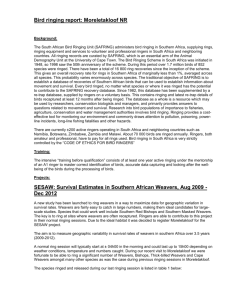

![Biography Sheet [ completed in . . . . ]](http://s3.studylib.net/store/data/007665571_2-959d35b51030d7940469f3dc5782636a-300x300.png)
